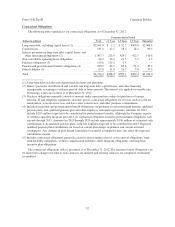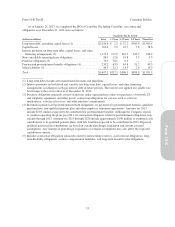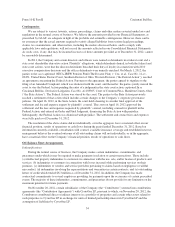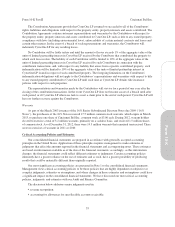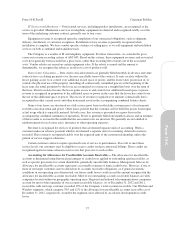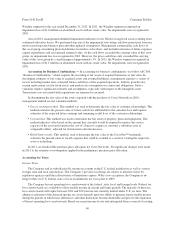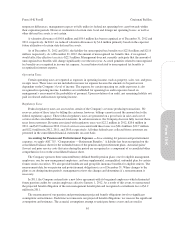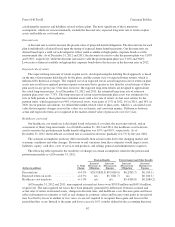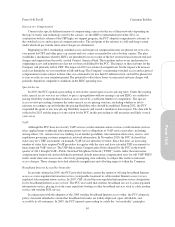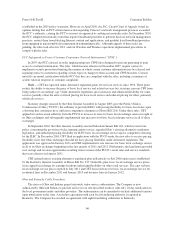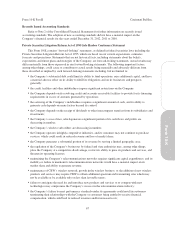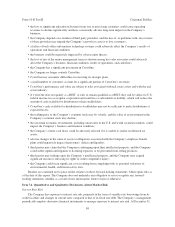Cincinnati Bell 2012 Annual Report Download - page 132
Download and view the complete annual report
Please find page 132 of the 2012 Cincinnati Bell annual report below. You can navigate through the pages in the report by either clicking on the pages listed below, or by using the keyword search tool below to find specific information within the annual report.Reviewing the Carrying Values of Goodwill and Indefinite-Lived Intangible Assets — The Company
adheres to the amended guidance under ASC 350-20 in testing goodwill for impairment. Under this revised
guidance, the Company has the option of performing a qualitative assessment for impairment prior to performing
the quantitative tests. In 2012, the Company adopted this new guidance but elected to perform a quantitative
assessment of goodwill for all reporting units in 2012. The Company performs impairment testing of goodwill
and indefinite-lived intangible assets on an annual basis, or when events or changes in circumstances indicate
that an asset may be impaired. We perform our annual impairment tests in the fourth quarter when our five-year
plan is updated.
Management estimates the fair value of each reporting unit using a combination of valuation methods,
including both income-based and market-based methods. The income-based approach utilizes a discounted cash
flow model using projected cash flows derived from the five-year plan, adjusted to reflect market participants’
assumptions. Expected future cash flows are discounted at the weighted average cost of capital applying a market
participant approach. The market-based approach utilizes earnings multiples from comparable publicly-traded
companies.
In 2011, our Wireless reporting unit recognized a goodwill impairment loss of $50.3 million due to declines
in revenues and wireless subscribers. Fair value of the reporting unit was estimated using both an income
approach and market approach. The income approach was weighted more heavily than the market approach due
to projections of declining revenues. No impairment losses were recognized on goodwill in 2012 or 2010. In
2012, the estimated fair value of goodwill exceeded the carrying value of goodwill by more than 25% for all
reporting units.
In July 2012, the FASB amended the guidance in ASC 350-30 on testing indefinite-lived intangibles assets,
other than goodwill, for impairment. Under the revised guidance, an entity testing an indefinite-lived intangible
asset for impairment has the option of performing a qualitative assessment before performing quantitative tests.
If the entity determines, on the basis of qualitative factors, that the fair value of the indefinite-lived intangible
asset is not more likely than not impaired, the entity would not need to perform the quantitative tests. In 2012, we
adopted this guidance for our impairment tests of indefinite-life intangible assets.
Wireless owns FCC wireless spectrum licenses which are indefinite-lived intangible assets. These licenses are
generally renewed every ten years for a nominal fee, provided we continue to meet the service and geographic
coverage provisions required by the FCC. In 2012, management performed a qualitative assessment of impairment
on this asset and concluded it was more likely than not that no impairment had occurred. The key qualitative factors
that affect the fair value of licensed spectrum consists of regulatory use, population characteristics, population
density, position of the spectrum within the spectrum band, quantity and frequency of use. Our analysis of these
factors indicated favorable market characteristics for spectrum in our operating territory, continued increases in
customer demand for data and wireless applications, and no additional supply of spectrum in our operating territory.
In 2011, a quantitative approach was utilized to test this asset for potential impairment. The fair value of
these licenses was determined by using both the “Greenfield” method and the “Auction” method. The Greenfield
method is an income approach technique that presents the expected economics of an actual asset using a
hypothetical set of operating assumptions. Specifically, in this approach, a hypothetical start-up of a business is
assumed wherein the only asset of the business is the spectrum being analyzed. The Auction method measures
the value of the spectrum by examining transactions in the marketplace involving the sale of spectrum with
attributes similar to those of the subject. The Greenfield method was weighted more heavily than the Auction
method due to limited transactions in the market. As of December 31, 2011, the fair value of these licenses
exceeded the carrying value of this asset by 25%. No impairment was recognized on these licenses in 2012, 2011
or 2010.
Changes in certain assumptions could have a significant impact on the impairment tests for goodwill and
indefinite-lived intangible assets. The most critical assumptions are projected future growth rates, operating
margins, capital expenditures, terminal values, and discount rate selection. These assumptions are subject to
change as the Company’s long-term plans and strategies are updated each year.
58
Form 10-K Part II Cincinnati Bell Inc.






